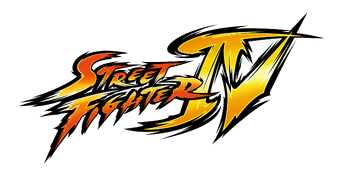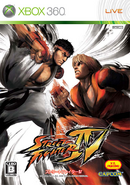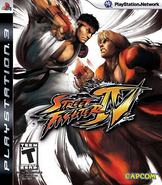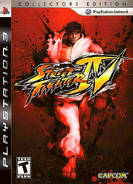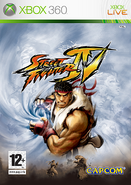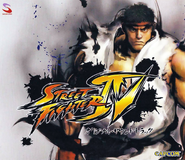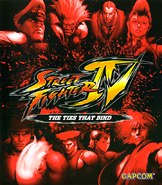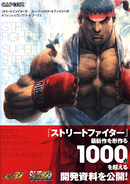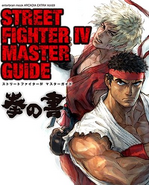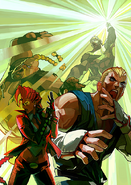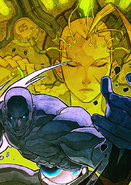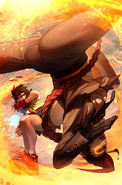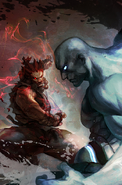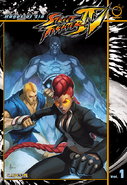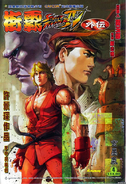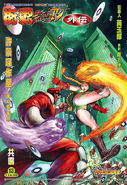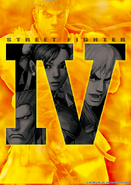Street Fighter IV (ストリートファイターIV Sutorīto Faitā Fō) is a 2008 fighting game produced by Capcom. It is the first Street Fighter game in the main series released by Capcom since the arcade release of Street Fighter III: 3rd Strike in 1999 and the first game in the IV sub-series. The arcade version was released in Japan on July 18, 2008 and was given a limited release in North American arcades in August. Home versions were released for the PlayStation 3 and Xbox 360 on February 12, February 16, and February 20 in Japan, North America, and Europe respectively.

Street Fighter IV
Intro and Demo Mode
The Windows version of the game was released on July 2, July 3, and July 7, 2009 in Japan, Europe, and North America respectively. The iOS version of the game was released on March 10, 2010. The latest release of the game is on Android OS, released on January 5, 2012.
Gameplay[]
While Street Fighter IV features fighters and backgrounds rendered in 3D, the gameplay remains on a traditional 2D plane. Producer Yoshinori Ono has stated that he wanted to keep the game closer to Street Fighter II than its sequels, and as such the parry system from Street Fighter III has been dropped. A new system called Focus Attacks (Saving Attack in the Japanese version) has been introduced, as well as Ultra Combos. The traditional six-button control scheme returns, with new features and special moves integrated into the input system, mixing classic gameplay with additional innovations.
The game has a very similar feel to Super Street Fighter II Turbo, but also has several natures from Street Fighter III 3rd Strike. Pressing both light attack buttons is still for throwing, and both heavy attack buttons are for the personal action or taunts. Both medium attack buttons are for the newly added Focus Attack. Dashes and quick standing are also in the game.
It was intended that the car-smashing bonus rounds from earlier Street Fighter games would return. Ono later stated that the bonus stages would not be in the arcade game, citing the reason to be that the time players spend on bonus stages takes money from arcade operators. This may also explain the option to turn off the bonus stages in the arcade mode on the home console versions of Super Street Fighter IV.
Visuals[]
The characters and environments in the game are rendered as 3D models with polygons but use a stylized effect to give them a hand-drawn look, with certain select attacks displaying ink sprays during the fights. The art director and character designer is Daigo Ikeno, who previously worked on Street Fighter III: 3rd Strike, aims at staying true to the Street Fighter II style.
Focus Attacks[]
Focus Attacks, known as Saving System in the Japanese version, was a new system introduced in Street Fighter IV. The Focus Attack is a move that allows the player to absorb an attack and launch a counterattack, and it is performed by pressing the medium punch and kick buttons simultaneously. The system aims to make ground attacks as viable a way of approaching opponents as jumping was in previous games. The Focus Attack system is a core part of Street Fighter IV gameplay.
Ultra Combos[]
Super Combos, the powered-up special moves that have been a series' mainstay since Super Street Fighter II Turbo, return in Street Fighter IV. Similar to Super Turbo, each character has one set super move. The game also features EX Special Moves, the powered-up versions of Special Moves from the the home version of Street Fighter: The Movie. In addition to Super Combos, the game also features Ultra Combos. Ultra Combos are performed similarly to the character's Super Combo but are executed with three attack buttons (much like the Lv. 3 Super Combos in the Street Figher Alpha series and the Meteor Combos in Street Fighter EX3). Ultra Combos are long and cinematic moves usually featuring a lengthy combination of punches, kicks and other moves. Just as there is a Super Combo Gauge, there is also an Ultra Combo gauge (officially known as the Revenge Gauge), but whereas the Super Combo meter fills as the player hits an opponent, the Revenge Gauge fills when one takes damage from the opponent. Along with Super Combos, Ultra Combos are one of the only times the camera breaks from its normal fixed position to show a more dynamic, or cinematic view of the gameplay. Additionally, when the camera shifts to this cinematic view, the opponent's facial expression will change to a look of surprise and panic. This is easier to see on some Ultra Combos than others, especially if the camera pans around the person in some way.
Characters[]
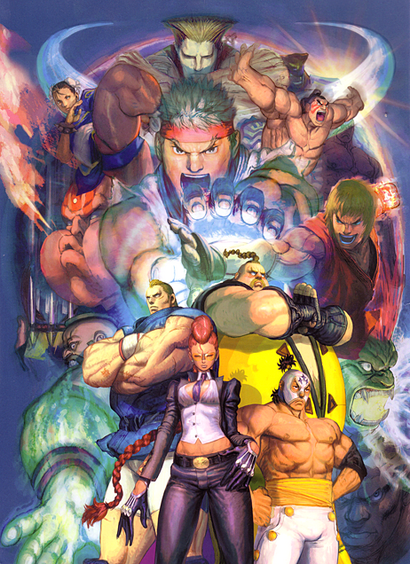
Group shot. Art by Ikeno.
| Returning Roster |
|---|
| Akuma |
| Balrog |
| Blanka |
| Cammy (Home console version) |
| Chun-Li |
| Dan (Home console version) |
| Dee Jay (iPhone/iPad version) |
| Dhalsim |
| E. Honda |
| Fei Long (Home console version) |
| Gen (Home console version) |
| Guile |
| Ken Masters |
| M. Bison |
| Rose (Home console version) |
| Ryu |
| Sagat |
| Sakura (Home console version) |
| Vega |
| Zangief |
| New Characters |
|---|
| Abel |
| C. Viper |
| El Fuerte |
| Gouken |
| Rufus |
| Seth (Final boss) |
| Cameos |
|---|
| Adon |
| Yang |
| Yun |
Story[]
The game takes place a few months after the events of Street Fighter ll but before the events of Street Fighter III. The S.I.N corporation began another fighting tournament in order to draw out powerful fighters to complete the BLECE project. Each character ohas their own reasons for entering this tournament, but S.I.N.'s real desire is to lure Ryu to them in order to analyze the Satsui no Hadou, believed to be the last piece of data needed to complete BLECE.
The tournament is publicly organized by S.I.N., apparently using preliminary matches and a point system to determine who is allowed to enter (as shown by the conversation between Seth and his lackey about how Dan Hibiki was able to "squeak by with just enough points to qualify").
Development[]
Before producer Yoshinori Ono pitched the idea to former Capcom R&D head Keiji Inafune, the prevailing attitude around Capcom was that a new numeric entry to the Street Fighter series would not be made. Initially, there was much resistance to Ono's pitch for a new Street Fighter game so many years after the original. The gap from 2000 to 2008, since Street Fighter EX3, the latest Street Fighter game at that point, represented the longest time the series had gone without a sequel. However, in light of fan demand plus the positive reception to Street Fighter II' Hyper Fighting on Xbox Live Arcade, Inafune eventually allowed the project to begin.[1] This was Ono's first take on a new entry for the Street Fighter series as a producer, although he had previously worked on Street Fighter III 3rd Strike as a "sound management director" and previously produced Capcom Fighting Jam. The experience provided by Super Street Fighter II Turbo became the main influence for the Street Fighter IV development team.[2]
The original game concept, titled Street Fighter IV Flashback, imagined in part by David Sirlin, the designer of Super Street Fighter II Turbo HD Remix, never made it past the proposal stage. Flashback would likewise feature the 2.5D gameplay and a roster made of classic Street Fighter II characters plus Sakura and a few new characters. The game would have also featured a single-player mode with third-person 3D action (similar to that of Sony's God of War series) that focused on Ryu's backstory, as well as all Street Fighter arcade games in their original forms and a 3D version of Super Turbo. Flashback's proposed easy control system was later used in Tatsunoko vs. Capcom: Ultimate All-Stars, minus its titular "flashback" gameplay feature.[3]
While Street Fighter IV features models and backgrounds rendered in 3D, the gameplay remains on a traditional 2D plane, with the camera having freedom to move in 3D at certain times during fights, for dramatic effect, similar to the Street Fighter EX series Capcom produced with Arika. Initially the title had been developed to use 3D hitboxes, but the testers felt it didn't have the "pixel perfect" precision of a Street Fighter game, and the game was therefore changed to use 2D hitboxes.[4] Ono has also cited the arcade version of Arc System Works' Battle Fantasia as the inspiration for the game's three-dimensional art style.[5]
Art director and character designer Daigo Ikeno, who previously worked on Street Fighter III 3rd Strike,[6] opted for non-photorealistic rendering to give them a hand-drawn look, with visual effects accented in calligraphic strokes, ink smudges and ink sprays during the fights.
The game runs on the Taito Type X2 arcade board inside a Taito Vewlix cabinet[7] and takes advantage of the Type X2's network capabilities and allows players in separate machines within the same LAN to fight each other.
Versions[]
This section is currently incomplete.
You can help Capcom Database by expanding it.
Reception[]
This section is currently incomplete.
You can help Capcom Database by expanding it.
Gallery[]
Box Art[]
Merchandise[]
References[]
- ↑ cite news|title=The Big Comeback|last=Bettenhausen|first=Shane|date=January 2008|work=Electronic Gaming Monthly|publisher=Ziff Davis|volume=224|pages=62–72
- ↑ http://www.gametrailers.com/player/usermovies/194282.html
- ↑ http://www.siliconera.com/2009/02/17/before-street-fighter-iv-there-was-street-fighter-iv-flashback/
- ↑ http://www.destructoid.com/sfiv-s-3d-polygons-could-have-ruined-hit-detection-172084.phtml
- ↑ https://web.archive.org/web/20091109161513/http://www.gamasutra.com/view/feature/3791/saving_street_fighter_yoshi_ono_.php?page=3
- ↑ https://web.archive.org/web/20151117021923/http://www.1up.com/do/previewPage?pager.offset=1&cId=3165156
- ↑ http://www.famitsu.com/game/news/1213478_1124.html

